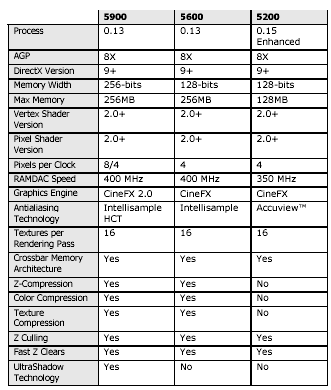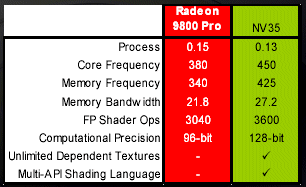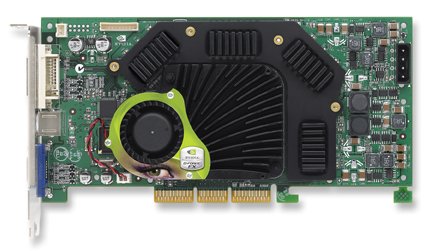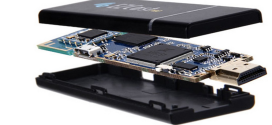Will the FX5900 GPU’s help NVIDIA regain the place at the top or will it be another disappointment like the FX5800 Ultra was?
Introduction
It is no secret that the launch of NVIDIA’s FX series of cards didn’t go as smoothly as expected. A paper-launch that promised a lot, followed by silence, more silence and then a high-end product that didn’t manage to touch the main competitor’s ‘old’ product – not what computer users expected. Would the FX be the start of NVIDIA’s downfall (like the delays were for Rendition and 3dfx)?
Nah, things are not as grim as some would like to portray. First of all, just because the FX was late, that does not mean NVIDIA didn’t have other products to sell. In fact – regardless of all problems, NVIDIA managed to keep their market share up. I guess all those GF4 Ti’s and GF4MX’s still sold pretty well. Second – the FX line is not just the FX 5800 Ultra. Even though the high-end card has failed to impress, the other FX products (FX5200 and FX5600) do perform well, given their market niche. So what to do about the high-end?
As has been said many times, NVIDIA has more than one team designing chips. So – even though the NV30 got delayed, the work on the NV35 (and probably NV40) moved forward as expected. This is why NVIDIA can reveal the FX 5900 (NV35) as their new high-end today. This preview will give you an idea of what the chip can do, as well as provide you with the first benchmarks. Can it compete with ATI’s finest?
Technical Info
What does the NV35 do different from the FX5x00?
Yes – finally! 256-bit memory interface. The number one complaint of the FX5800 has been fixed. NVIDIA probably never will admit that they were wrong in putting just a 128-bit interface on the FX5800, but who cares now. It should also be noted that NVIDIA has dropped DDRII memory and instead chosen to use the cheaper DDR memory. This should help keep the price down.
If we look at the ATI Radeon 9800 Pro, the new FX5900 will indeed be able to compete on a technical level (we’ll talk more about benchmarks later).
Let us look a bit closer on the things that have been improved:
- 256-bit memory-interface. By doubling the memory paths, the FX5900 GPU’s can transfer twice as much data as the FX5x00 GPU’s. I don’t think I need to tell you why this is a good thing, especially at higher resolutions and with quality enhancement features turned on.
- CineFX 2.0 The NVIDIA CineFX 2.0 engine optimizes all stages of the pixel pipeline, doubling the floating-point pixel shader power of its predecessor. This major jump forward translates directly to a 2× increase in floating-point shader power, and a visible performance boost from the faster, more efficient execution of pixel shader programs.
- Intellisample HCT The updated Intellisample technology compresses color, texture, and Z data even more. This should allow for even more speed at higher resolutions and AA.
- UltraShadow Basically it is all about accelerating shadows via both hardware and software. UltraShadow gives programmers the ability to calculate shadows much more quickly, by allowing them to define a scene bounding region, which limits calculations of lighting sources to objects within a specified volume. By limiting calculations to the area most affected by a light source, the overall shadow generation process can be greatly accelerated. At the same time, the hardware is able to do the shadow volume rendering in a single pass (in contrast, other graphical solutions use 2 passes to render stenciled shadow volumes). At the same time, the Intellisample HCT makes sure the shadow edges are properly antialiased.
Cool fan/heatsink that covers the memory. No more leaf-blower!
Enough of the technical talk. What can this puppy do? Scott took the FX5900 Ultra on a spin in his computer.
System
In this initial preview, we compare the FX 5900 Ultra to the ATI Radeon 9700 Pro. Unfortunately, we were unable to get a Radeon 9800 Pro in time for the preview, but we have a few coming in, so we hope to be able to update this preview with scores from both a Radeon 9800 Pro and the FX5800 Ultra soon. If we take the scores from my preview of the Radeon 9800 Pro, we see that it draws ahead of my 9700 Pro by 15-30%.
3DMark2001SE
Setting: Default
| GFX Card/GPU | Score |
|
1024×768
|
|
| FX5900 Ultra | |
| ATI Radeon 9700 Pro | |
|
1280×1024
|
|
| FX5900 Ultra | |
| ATI Radeon 9700 Pro | |
|
1600×1200
|
|
| FX5900 Ultra | |
| ATI Radeon 9700 Pro |
Setting: 4xAA and 8x Anisotropic filtering
| GFX Card/GPU | Score |
|
1024×768
|
|
| FX5900 Ultra | |
| ATI Radeon 9700 Pro | |
|
1280×1024
|
|
| FX5900 Ultra | |
| ATI Radeon 9700 Pro | |
|
1600×1200
|
|
| FX5900 Ultra | |
| ATI Radeon 9700 Pro |
Without any Antialiasing (AA) or Anisotropic Filtering (AF), the FX5900 Ultra barely edges ahead of the 9700 Pro. However, turn on AA and AF and the situation changes. The FX 5900 Ultra manages to draw ahead with about a 20-40% lead.
Comanche 4 demo
Setting: no AA, no AF
| GFX Card/GPU | Score |
|
1024×768
|
|
| FX 5900 Ultra | |
| ATI Radeon 9700 Pro | |
|
1280×1024
|
|
| FX 5900 Ultra | |
| ATI Radeon 9700 Pro | |
|
1600×1200
|
|
| FX 5900 Ultra | |
| ATI Radeon 9700 Pro |
Setting: 4xAA and 8x Anisotropic Filtering
| GFX Card/GPU | Score |
|
1024×768
|
|
| FX 5900 Ultra | |
| ATI Radeon 9700 Pro | |
|
1280×1024
|
|
| FX 5900 Ultra | |
| ATI Radeon 9700 Pro | |
|
1600×1200
|
|
| FX 5900 Ultra | |
| ATI Radeon 9700 Pro |
Comanche 4 is a very CPU-dependent benchmark. It is quite clear from the NoAA/NoAF scores that neither card is the limiting factor. However, turn on AA/AF and once again the FX5900 Ultra slowly draws ahead ending up with a 30% lead over the 9700 Pro.
| These images are from the Vulcan-demo. Vulcan, the god of fire, toils at his anvil forging the metals of the earth when one of the sparks of his forge takes flight. Angered, Vulcan attempts to crush the annoyance but its too quick. He chases it all around his sanctuary to no avail, as he’s too slow to vanquish the pest. Tired and dizzy, Vulcan makes one last attempt to get rid of the pest, but he’s overcome with fatigue and he fizzles. Key-features: Realistic fire, smoke, and glow using volumetric texturing and render-to-texture techniques | ||
UT2k3 – HardOCP High Quality – Antalus
Setting: No AA, No AF
| GFX Card/GPU | Score |
|
1024×768
|
|
| FX 5900 Ultra | |
| ATI Radeon 9700 Pro | |
|
1280×1024
|
|
| FX 5900 Ultra | |
| ATI Radeon 9700 Pro | |
|
1600×1200
|
|
| FX 5900 Ultra | |
| ATI Radeon 9700 Pro |
Setting: 4xAA and 8x Anisotropic Filtering
| GFX Card/GPU | Score |
|
1024×768
|
|
| FX 5900 Ultra | |
| ATI Radeon 9700 Pro | |
|
1280×1024
|
|
| FX 5900 Ultra | |
| ATI Radeon 9700 Pro | |
|
1600×1200
|
|
| FX 5900 Ultra | |
| ATI Radeon 9700 Pro |
UT2k3 – HardOCP High Quality – Inferno
Setting: No AA, No AF
| GFX Card/GPU | Score |
|
1024×768
|
|
| FX 5900 Ultra | |
| ATI Radeon 9700 Pro | |
|
1280×1024
|
|
| FX 5900 Ultra | |
| ATI Radeon 9700 Pro | |
|
1600×1200
|
|
| FX 5900 Ultra | |
| ATI Radeon 9700 Pro |
Setting: 4xAA and 8x Anisotropic Filtering
| GFX Card/GPU | Score |
|
1024×768
|
|
| FX 5900 Ultra | |
| ATI Radeon 9700 Pro | |
|
1280×1024
|
|
| FX 5900 Ultra | |
| ATI Radeon 9700 Pro | |
|
1600×1200
|
|
| FX 5900 Ultra | |
| ATI Radeon 9700 Pro |
UT2k3 paints a surprisingly different picture. Without AA/AF, the FX5900 Ultra crushes the 9700 Pro. However, turn on AA/AF and the lead becomes smaller as we move up the resolutions. It will be interesting to see what the Radeon 9800 Pro will get in the same benchmark, since in my preview it managed to edge ahead of the 9700 Pro with 20% in the Inferno map at 1600×1200 4xAA/8xAF.
The way it’s meant to be played

NVIDIA of course likes to make sure every game works best on a NVIDIA GPU. They have started the “The Way it’s Meant to Be Played” program where the ‘hottest’ games will get a seal showing potential customers with NVIDIA GPU’s that they can expect the best possible experience. Included with the material for this preview was a bunch of screenshots from upcoming hot games that of course will work great on an NVIDIA GPU:
| The power of the NVIDIA® GeForce FX 5900 enables lifelike shading on the players in Madden NFL 2004. |
Breed
|
LineageII
|
LineageII
|
|
City of Heroes: Two heroes battle a Freakshow Dreadnought
|
Abducted takes full advantage of the NVIDIA® UltraShadow technology, and places you in an incredibly detailed world of dynamic shadows and lurking danger.
|
Characters in Abducted feature lifelike, detailed facial expressions thanks to the power of the NVIDIA® GeForce FX GPUs.
|
The power of the NVIDIA® GeForce FX GPUs enables fantastic gaming experiences like those found in EAs Battlefield 1942: Secret Weapons of WWII.
|
When, what, how much?
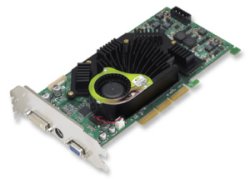 The FX5900 will be out in 3 different versions:
The FX5900 will be out in 3 different versions:
FX5900 Ultra
FX5900
NV35 Value
Together with the FX5200, FX5200 Ultra, FX 5600, and FX5600 Ultra, NVIDIA has covered the whole range of graphics cards, from low-end sub-$80 cards up to the high-end, with DirectX9 based cards. This in turn, should encourage the game developers to ship games that provide the DX9 based eye-candy we all crave. Conclusion
The whole mess with the NV30 did show us one thing – NVIDIA is a strong company that has the ability to stumble and yet move forward as planned. I’m sure they never expected the NV35 to actually replace the FX5800 Ultra before it came out, but that is what is actually happening. The preliminary benchmarks that we have done do indeed show that the FX5900 beats the Radeon 9700 Pro and very probably can keep up with the Radeon 9800 Pro, and is in many cases be even faster. The big question now is how fast NVIDIA can get these cards out on the street. The Radeon 9800 Pro just hit the streets, so it has a little advantage, but if NVIDIA can get the first cards out in June, they have caught up with ATI and leveled the playing field.
With the NV35, NVIDIA is back on track and can put the NV30 problems in the past and look forward.
 Bjorn3D.com Bjorn3d.com – Satisfying Your Daily Tech Cravings Since 1996
Bjorn3D.com Bjorn3d.com – Satisfying Your Daily Tech Cravings Since 1996
